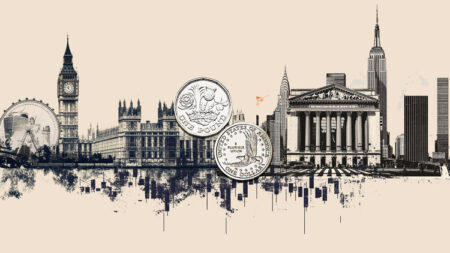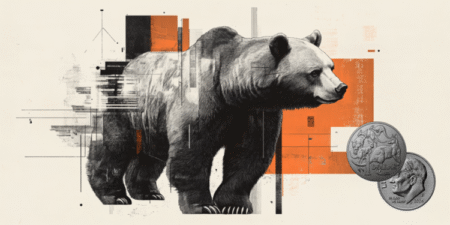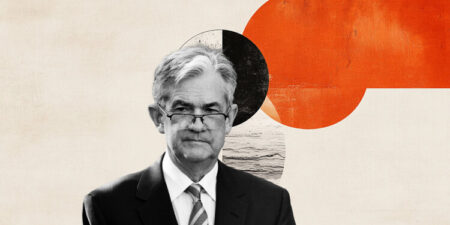- The Indian Rupee edges lower against the US Dollar amid trade talks between the US and India in Washington.
- US President Trump stated that a deal with India will increase Washington’s access to Indian markets.
- Fed officials warned that tariff-driven inflation has just started.
The Indian Rupee (INR) ticks down against the US Dollar (USD) on Thursday as the latter trades firmly, following confirmation from United States (US) President Donald Trump that he will not fire Federal Reserve (Fed) Chair Jerome Powell.
On Wednesday, a report from Bloomberg showed that Trump will likely fire Fed’s Powell soon. However, Trump denied those reports, while continuing to criticize thimefor not bringing interest rates down.
Another reason behind strength in the US Dollar is comments from Federal Reserve (Fed) officials indicating that the impact of tariffs announced by Washington will increase further.
“It’s early days for impact of tariffs on economy, which is modest so far but will increase over time,” New York Fed Bank President John Williams said in a speech at New York Association for Business Economics on Wednesday. Williams warned that Tariffs should boost inflation by “one percentage point rest of 2025 into 2026”.
Separately, Atlanta Fed President Raphael Bostic also warned while being interviewed by Fox Business that the headline inflation is “moving away from our target not towards it” due to an increase in prices of products from import-heavy sectors. We are seeing things underlying in the economy that suggest inflation pressures are up, and that’s really a source of concern, Bostic added.
Fears of a resumption in inflationary pressures on the upside were prompted after the US Consumer Price Index (CPI) report for June showed that prices of products that are imported into the US, such as household furnishings, recreation, and apparel rose sharply.
US Dollar PRICE Today
The table below shows the percentage change of US Dollar (USD) against listed major currencies today. US Dollar was the strongest against the Australian Dollar.
| USD | EUR | GBP | JPY | CAD | AUD | INR | CHF | |
|---|---|---|---|---|---|---|---|---|
| USD | 0.37% | 0.10% | 0.51% | 0.49% | 0.87% | 0.11% | 0.33% | |
| EUR | -0.37% | -0.27% | 0.12% | 0.15% | 0.53% | -0.20% | -0.01% | |
| GBP | -0.10% | 0.27% | 0.42% | 0.40% | 0.78% | -0.01% | 0.23% | |
| JPY | -0.51% | -0.12% | -0.42% | -0.04% | 0.32% | -0.41% | -0.19% | |
| CAD | -0.49% | -0.15% | -0.40% | 0.04% | 0.46% | -0.25% | -0.16% | |
| AUD | -0.87% | -0.53% | -0.78% | -0.32% | -0.46% | -0.71% | -0.55% | |
| INR | -0.11% | 0.20% | 0.01% | 0.41% | 0.25% | 0.71% | 0.20% | |
| CHF | -0.33% | 0.01% | -0.23% | 0.19% | 0.16% | 0.55% | -0.20% |
The heat map shows percentage changes of major currencies against each other. The base currency is picked from the left column, while the quote currency is picked from the top row. For example, if you pick the US Dollar from the left column and move along the horizontal line to the Japanese Yen, the percentage change displayed in the box will represent USD (base)/JPY (quote).
Daily digest market movers: Investors await confirmation of US-India trade deal
- The Indian Rupee faces a slight selling pressure around 86.00 against the US Dollar, while investors awaiting the confirmation of a trade deal between the US and India. US President Trump has reiterated several times that Washington is close to reaching a deal with New Delhi, however, no confirmed announcement has kept investors on the sidelines.
- On Wednesday, US President Trump expressed confidence in an interview aired on Real America’s Voice that he will sign a deal with India soon, while stating the possibility of a deal with the European Union (EU) too. “We’re [Washington] very close to India, and we could possibly make a deal with the EU,” Trump said, Reuters reported.
- Trump’s comments came at a time when India’s Chief Trade Negotiator Rajesh Agrawal-led team has reached Washington for the next round of trade talks. Earlier this week, Union Minister Piyush Goyal affirmed that both nations are working to reach a “win-win” agreement, Financial Express (FE) reported.
- Apart from the confirmation of a trade pact between India and the US, investors are also keen to know trade terms. Market experts believe that the removal of trade barriers by New Delhi for making a deal with Washington could expose Indian companies to capital-heavy corporations of the US. Such a scenario would lead to an intense competition for domestic companies that could weaken overall business sentiment.
- Earlier this week, US President Trump also stated that a trade pact with India will allow US access to Indian markets.
Technical Analysis: USD/INR faces selling pressure above 86.00
USD/INR trades cautiously near 86.00 on Thursday. The pair struggles to hold the 20-day Exponential Moving Average (EMA), which trades around 85.93, suggesting that the near-term trend is uncertain.
The 14-day Relative Strength Index (RSI) oscillates inside the 40.00-60.00 range, suggesting that the asset lacks momentum on either side.
Looking down, the May 27 low of 85.10 will act as key support for the major. On the upside, the June 24 low at 86.42 will be a critical hurdle for the pair.
Fed FAQs
Monetary policy in the US is shaped by the Federal Reserve (Fed). The Fed has two mandates: to achieve price stability and foster full employment. Its primary tool to achieve these goals is by adjusting interest rates.
When prices are rising too quickly and inflation is above the Fed’s 2% target, it raises interest rates, increasing borrowing costs throughout the economy. This results in a stronger US Dollar (USD) as it makes the US a more attractive place for international investors to park their money.
When inflation falls below 2% or the Unemployment Rate is too high, the Fed may lower interest rates to encourage borrowing, which weighs on the Greenback.
The Federal Reserve (Fed) holds eight policy meetings a year, where the Federal Open Market Committee (FOMC) assesses economic conditions and makes monetary policy decisions.
The FOMC is attended by twelve Fed officials – the seven members of the Board of Governors, the president of the Federal Reserve Bank of New York, and four of the remaining eleven regional Reserve Bank presidents, who serve one-year terms on a rotating basis.
In extreme situations, the Federal Reserve may resort to a policy named Quantitative Easing (QE). QE is the process by which the Fed substantially increases the flow of credit in a stuck financial system.
It is a non-standard policy measure used during crises or when inflation is extremely low. It was the Fed’s weapon of choice during the Great Financial Crisis in 2008. It involves the Fed printing more Dollars and using them to buy high grade bonds from financial institutions. QE usually weakens the US Dollar.
Quantitative tightening (QT) is the reverse process of QE, whereby the Federal Reserve stops buying bonds from financial institutions and does not reinvest the principal from the bonds it holds maturing, to purchase new bonds. It is usually positive for the value of the US Dollar.
Read the full article here
















